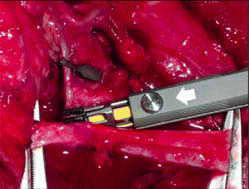The study included 67 men and 29 women whose average age was 65, with a range from 43 years to 92 years of age. Squamous cell carcinoma was the major indication for surgery.
Explore This Issue
August 2008A radial forearm flap was used in 76 procedures (79%), whereas a fibular flap was used in 17 operations (18%). In three patients the surgeons utilized a rectus abdominis flap (3%). The Unilink coupling device was used in this case series.
Overall, 134 patients in the series underwent 137 free flap procedures. Surgeons performed 173 end-to-side anastomoses in 96 patients. In 77 patients, doctors performed both anastomoses using the end-to-side procedure. In 17 patients, surgeons performed one end-to-side and one end-to-end anastomosis. In two patients one venous anastomosis was performed in end-to-side fashion.

We observed a 99% free flap survival rate, Dr. Chernichenko said. Three complications occurred in the series, she said, but in two cases doctors were able to prevent loss of the flap, resulting in a total of only one flap failure. The other cases involved vascular insufficiency-related complications. None of the anastomoses were converted to the suture technique, she said.
In the case that failed, 2.5 mm end-to-end anastomosis was performed using a radial free flap. A 3.0 mm end-to-side anastomosis was also performed. The flap was removed on postoperative day 20. Both venous anastomoses were clotted, she said.
Implications of the Study
This coupler has been in service for decades, but it was designed as an end-to-end device, said Mark C. Weissler, MD, the J.P. Riddle Distinguished Professor of Otolaryngology at the University of North Carolina-Chapel Hill.
Dr. Chernichenko has shown that you can use it as an end-to-side device and has had wonderful results with it, said Dr. Weissler, who chaired the session at the Triological Society meeting. This is useful information. A lot of people do the end-to-side approach, but they do not use the coupler.
 Microvascular free tissue transfers have become the mainstream of reconstruction following resection of head and neck tumors. Despite numerous refinements, microvascular anastomosis is the most challenging aspect of the procedure.
Microvascular free tissue transfers have become the mainstream of reconstruction following resection of head and neck tumors. Despite numerous refinements, microvascular anastomosis is the most challenging aspect of the procedure.-Natalya Chernichenko, MD
Dr. Weissler, who is also Chair of the UNC Clinical Cancer Advisory Committee and a clinical researcher at the Lineberger Comprehensive Cancer Center, noted, Some plastic surgeons are so facile that they may not need the coupler. But I think most surgeons could use it to save time. Most would use the coupler for the vein and sew the artery.
Leave a Reply